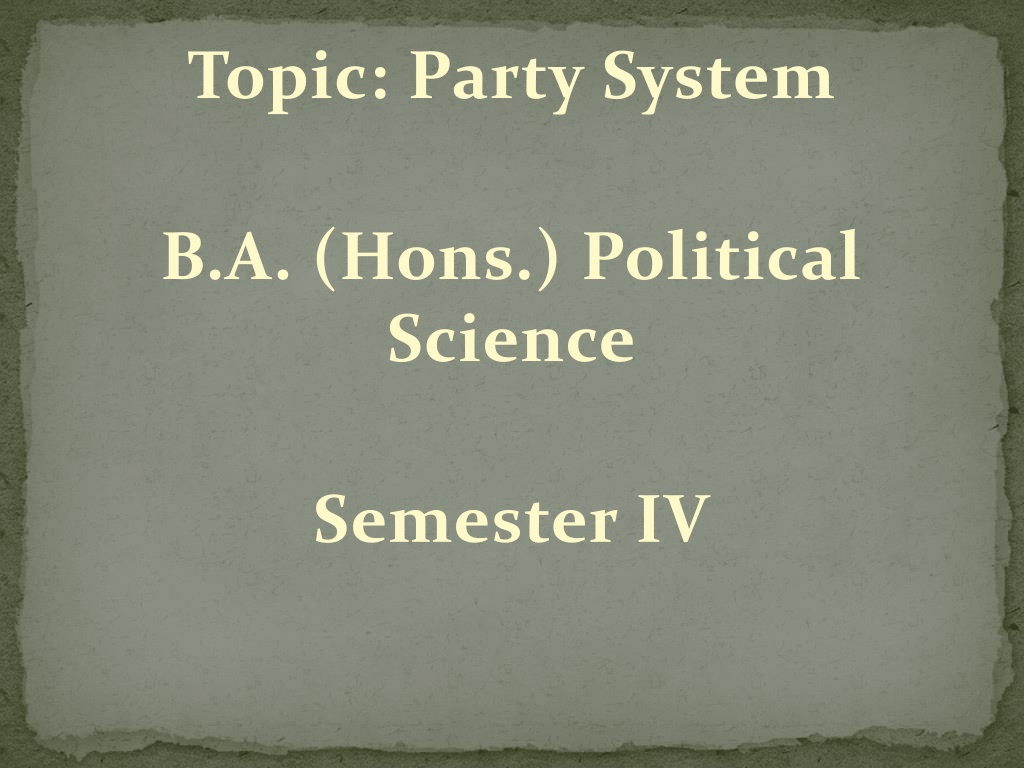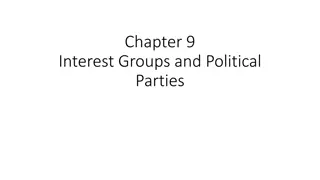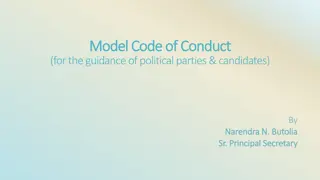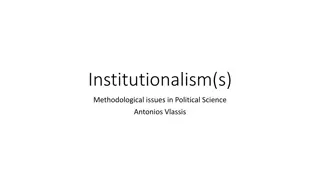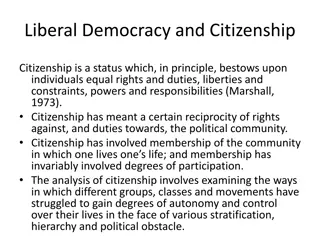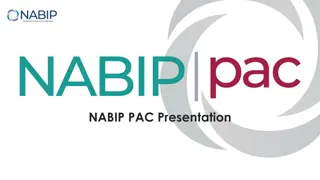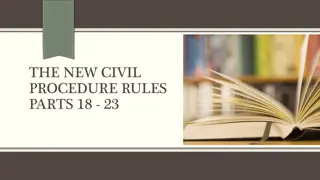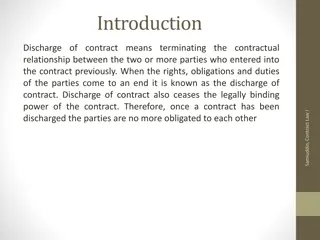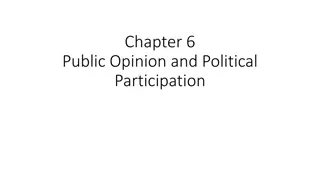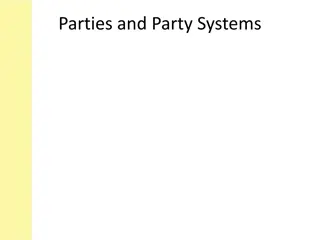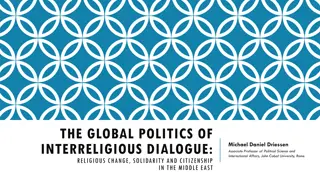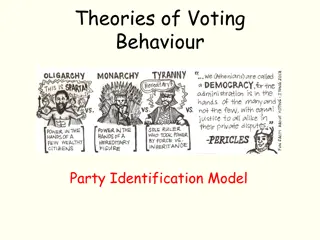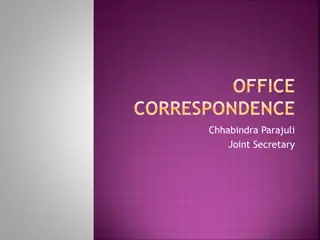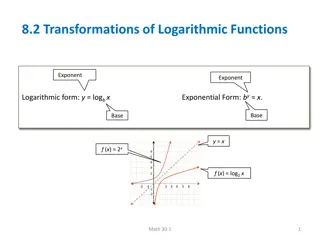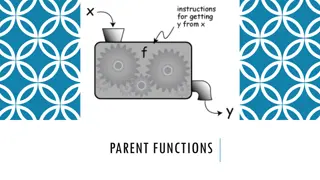Understanding Political Parties: Types and Functions
Political parties are organized groups aiming to acquire and exercise political power, influencing governments through various means. They can be cadre parties, mass parties, or catch-all parties, with distinct characteristics. Left-wing and right-wing parties differ in their approaches to change and continuity. Parties play crucial roles in representation and the organization of government.
Download Presentation

Please find below an Image/Link to download the presentation.
The content on the website is provided AS IS for your information and personal use only. It may not be sold, licensed, or shared on other websites without obtaining consent from the author. Download presentation by click this link. If you encounter any issues during the download, it is possible that the publisher has removed the file from their server.
E N D
Presentation Transcript
Topic: Party System B.A. (Hons.) Political Science Semester IV
POLITICAL PARTY: CONCEPT Political party, a group of persons organized to acquire and exercise political power. The obvious way to obtain such power is to gain control of the government, but political parties also exercise power by influencing the policies of governments not under their control. Political parties originated in their modern form in Europe and the United States in the 19th century, along with the electoral and parliamentary systems, whose development reflects the evolution of parties. The term party has since come to be applied to all organized groups seeking political power, whether by democratic elections or by revolution.
TYPES OF PARTY 1. CADRE PARTIES Cadre parties developed in Europe and America during the 19th century. Dominated by an informal group of leaders who saw little point in building up a mass organization. The mass of people were limited to the role of spectators rather than that of active participants. The cadre parties of the fundamental conflict between two classes: the aristocracy on the one hand and the bourgeoisie on the other. The former, composed of landowners, depended upon rural estates on which a generally unlettered peasantry was held back by a traditionalist clergy. The bourgeoisie, made up of industrialists, merchants, financiers, and professional people, depended upon the lower classes of clerks and industrial workers in the cities. 19th century reflected a tradesmen, bankers,
2. MASS PARTIES Mass-based parties, on the other hand, unite hundreds of thousands of followers, sometimes millions. number of members is not the only criterion of a mass- based party. The essential factor is that such a party attempts to base itself on an appeal to the masses. At the end of the 19thcentury, the socialist parties of continental Europe organized themselves on a mass basis in order to educate and organize the growing population of labourers and wage earners and to gather the funds necessary for contesting elections. Places heavy emphasis on broadening membership and construct a wide electoral base. 3. CATCH-ALL PARTIES Parties that drastically reduce their ideological baggage in order to appeal to the largest possible number of voters. Attracts people from all sections and communities. But the
LEFT AND RIGHT WING PARTIES The Left-wing parties are characterized by a commitment to change, wholesale economic examples: progressive, communist parties. in the form of transformation. socialist For and The Right-wing parties, generally, uphold the existing social order and are, in that sense, a force for continuity. For example: conservative and fascist parties.
FUNCTIONS OF PARTIES 1. Representation: The capacity of parties to respond to and articulate the views of both members and the voters. They represent people s concerns and needs at both governmental and non-governmental platforms. 2. Organization of government: Parties help with the formation of governments. 3. Elite formation and responsible for providing states with their political leaders. They also provide politicians; equipping them with skills, knowledge and experience. 4. Goal formation: They government (through conferences, parliamentary debates and deliberations, conventions, election manifestos and so on) with a view to attracting popular support. recruitment: Parties are a training ground for formulate programs of
5. Select Candidates: Political parties nominate candidates for political office. They narrow the field from a multitude of wannabes to a manageable few credible candidates. This simplifies the voters role and brings a certain order to what could be a chaotic electoral process. 6. Interest articulation and aggregation: They help to articulate and aggregate the various interests found in a society. 7. Socialization and mobilization: debates and discussions as well as campaigning and electoral competition, parties are important agent of political education and socialization. 8. Facilitate Governance: Parties also bring order to the process of policymaking. As party members, individual politicians have a ready-made group of allies that usually cooperate with their efforts legislation. Through internal to pass and implement
PARTY SYSTEMS Party systems are typically categorised according to the number of parties that participate meaningfully in the struggle for power. It may be broken down into three broad categories: two-party, multiparty, and single-party. Such a classification is based not merely on the number of parties operating within a particular country but on a variety of distinctive features that the three systems exhibit. Two- party and multiparty systems organizing political conflict within pluralistic societies and are thus part of the apparatus of democracy. Single parties, on the other hand, usually operate in situations in which genuine political conflict is not tolerated. 1. ONE-PARTY SYSTEMS: A single-party state, one-party state, one-party system, or single-party system is a type of state in which a single political party has the right to form the government, usually constitution. represent means of based on the existing
There have been three historical forms of the single-party system: communist, fascist, developing countries. A) The communist model: In communist countries of the 20th century, the party was considered to be the spearhead of the urban working class and of other workers united with it (peasants, intellectuals, etc.). Its role was to aid in the building of a socialist regime during the transitory phase between capitalism and pure socialism, called the dictatorship of the proletariat. and that found in the B) The fascist model: Fascist parties in a single-party state have never played as important a role as communist parties in an analogous situation. In Italy, the Fascist Party was never the single most important element in the regime, and its influence was often secondary. Only in Germany did the National Socialist Party have a great influence on the state.
But, in the end, Adolf Hitlers dictatorship was dependent on his private army, the SS (Schutzstaffel), which formed a separate element within the party and which was closed to outside influences. The fascist party in the single-party state has a policing or military function rather than an ideological one. After their rise to power, the fascist parties in both Germany and Italy gradually function of maintaining contact between the people and the government, a function that is usually performed by the party in a single-party situation. It was possible to observe a tendency for the party to close in upon itself while suppressing its deviant members. The renewal of the party was then assured through recruitment from youth organizations, from which the most fanatical elements, the products of a gradual selection process starting at a very early age, entered the party. The party tended, therefore, to constitute a closed order ceased to perform the
C) The single party in the developing countries: Some of the communist parties in power in developing countries did not differ significantly from their counterparts in industrialized countries. This is certainly true of the Vietnamese Communist Party and the Workers Party of North Korea. There have always been, however, countries in which the single party characterized in terms of counterpart. This observation applied to, for example, the former Arab Socialist Union in Egypt and the Democratic Constitutional Rally (formerly the Neo-Destour Party) during its period of dominance of Tunisian politics (1956 2011). Most of these parties claimed to be more or less socialist or at least progressive, while remaining far removed from communism and, in some communism. in a power traditional could not be European cases, ardent foes of
Cont. Single parties in developing countries are rarely as well organized as communist parties. In Turkey, the Republican People s Party was more a cadre party than a mass-based party. In Egypt, it was necessary to organize a core of professional politicians within pseudoparty of the masses. In sub-Saharan Africa, the parties were most often genuinely mass-based, but the membership appears to be personal attachment to the leader or by tribal loyalties, and organization is not usually very strong. It is this weakness in organization that explained the secondary role played by such parties in government. the framework of a motivated primarily by
2. TWO-PARTY SYSTEMS: A two-party system is a system where two major political parties dominate politics within a government. One of the two parties typically holds a majority in the legislature and is usually referred to as the majority party while the other is the minority party . A fundamental distinction must be made between the two- party system as it is found in the United States and as it is found in Great Britain. Although dominate political life in the two countries, the system operates in quite different ways. A) American two-party system: The United States has always had a two-party system, first in the opposition between the Federalists and the Anti-Federalists and then in the competition between the Republicans and the Democrats. There have been movements in the history of the country, but they have always failed. Presidential elections seem to have played an important role in the formation of this type of two- party system. two major parties frequent third-party
The mechanism of a national election in so large a country has necessitated very large political organizations and, at the same time, relatively simplified choices for the voter. American parties are different from their counterparts in other Western countries. They are not tied in the same way to the great social and ideological movements that have so influenced the development of political life in Europe during the last two centuries. There have been socialist parties at various times in the history of the United States, but they have never challenged the dominance of the two major parties. In therefore, American parties have appeared as two varieties of one liberal party, and within each party can be found a wide range of opinion, going from the right to the left. comparison with European political movements,
The American parties have a flexible and decentralized structure, marked by the absence of discipline and rigid hierarchy. This was the structure of most of the cadre-type parties of the 19th century, a structure that most liberal parties have retained. Organization may be relatively strong and homogeneous at the local level, but such control is much weaker on the state level and practically non-existent on the national level. There is some truth to the observation that the United States has not two parties but 100 that is, two in each state. But it is also true that each party develops a certain degree of national unity for the presidential election and that the leadership of the president within his party gives the victorious party some cohesion. The lack of rigid party encouraged bipartisanship Democratic members of Congress. structure between has Republican historically and
Through Democrats tended to ally against conservative Republicans and Democrats. Yet neither bloc was stable, and the alignment varied from one consequence, despite the existence of a two-party system, no stable legislative majority was possible. In order to have his budget adopted and his legislation passed, the president of the United States was forced to carefully gather the necessary votes on every question, bearing the wearisome task of constantly forming alliances. the 20th century, liberal Republicans and vote to another. As a The American two-party system was thus a pseudo-two- party system, because each party provided only a loose framework within which shifting coalitions were formed. Against this general tendency, however, voting has become increasingly partisan since about the first decade of the 21st century.
B) BRITISH TWO-PARTY SYSTEM Another form of the two-party system is operative in Great Britain and in New Zealand. The situation in Australia is affected somewhat by the presence of a third party, the Nationals (formerly the Australian Country Party). A tight alliance between the Nationals and the National Party of Australia introduces, however, bipolarization with the Labour Party. The system thus tends to operate on a two-party basis. possesses what is essentially a two-party system: Liberals or Conservatives have usually been able to form a working majority without the help of small, regionally based parties. The country has, however, deviated from this pattern since the 1990s, with the election of the Bloc Qu b cois (1993) and the New Democratic Party (2011) as the country s official opposition. a rather rigid Canada also
Great Britain has had two successive two-party alignments: Conservative and Liberal prior to 1914 and Conservative and Labour since 1935. The period from 1920 to 1935 constituted an intermediate Britain s Conservative Party is actually a Conservative- Liberal Party, resulting from a fusion of the essential elements of the two great 19th-century parties. Despite the name Conservative, its ideology corresponds to political and economic liberalism. A similar observation could be made about the other major parties, such as the German Christian Democratic Party. The British two-party system depends on the existence of rigid parties; that is, parties in which there is effective discipline regarding parliamentary voting patterns. In every important vote, all party members are required to vote as a bloc and to follow to the letter the directives that they agreed upon collectively or that were decided for them by the party leaders. phase between the two. European conservative
A relative flexibility may at times be tolerated, but only to the extent that such a policy does not compromise the action of the government. It may be admissible for some party members to abstain from voting if their abstention does not alter the results of the vote. Thus, the leader of the majority party (who is at the same time the prime minister) is likely to remain in power throughout the session of Parliament, and the legislation he or she proposes will likely be adopted. There is no longer any real separation of power between the executive and legislative branches, for the government majority form a homogeneous and solid bloc before which the opposition has no power other than to make its criticisms known. During the four or five years for which a Parliament meets, the majority in power is completely in control, and only internal difficulties within the majority party can limit its power. and its parliamentary
Since each party in Britain is made up of a disciplined group with a recognized leader who becomes prime minister if his or her party wins the legislative elections, these elections perform the function of selecting both the legislature and the government. In voting to make one of the party leaders the head of the government, the British assure the leader of a disciplined parliamentary majority. The result is a political system that is at once stable, democratic, and strong; and many would argue that it is more stable, more democratic, and stronger than systems anywhere else. 3. MULTIPARTY SYSTEMS: A multi-party system is a system in which multiple political parties have the capacity to gain control of government offices, coalition. Apart from one-party and two-party systems, multi-party systems tend parliamentary systems than presidential systems. separately or in to be more common in
Some of the key features of multiparty systems: Different parties exist and operate, including anti- system; not revolutionary character The degree of ideological distance may be discovered between different parties Existence of different parties differing not only in policies but more importantly fundamentals on principal Existence of irresponsible opposition- lacks a strong well-organised opposition party The ruling party or other ones may cause inflationary disequilibrium by making tall promises to the voters Multi-party coalitions- for example a far left and center left party coming together to pass legislation Wider Representation to different societal groups and communities Expensive Exercise
CONCLUSION Party system is one of the many factors of a healthy democratic process. It enables the people to be represented to the government. Highlights their participation in the political process of the state provided that their claims are considered by the party politicians in concocting their platforms, and in the long run, will be a guide in framing policies. ***The End***
